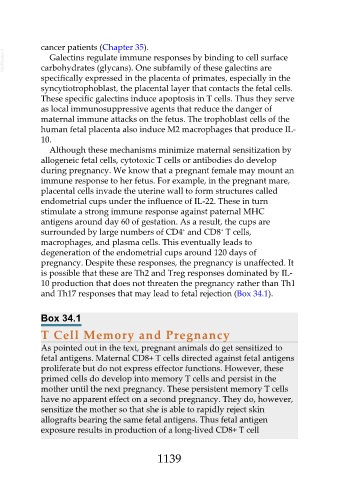Page 1139 - Veterinary Immunology, 10th Edition
P. 1139
cancer patients (Chapter 35).
VetBooks.ir carbohydrates (glycans). One subfamily of these galectins are
Galectins regulate immune responses by binding to cell surface
specifically expressed in the placenta of primates, especially in the
syncytiotrophoblast, the placental layer that contacts the fetal cells.
These specific galectins induce apoptosis in T cells. Thus they serve
as local immunosuppressive agents that reduce the danger of
maternal immune attacks on the fetus. The trophoblast cells of the
human fetal placenta also induce M2 macrophages that produce IL-
10.
Although these mechanisms minimize maternal sensitization by
allogeneic fetal cells, cytotoxic T cells or antibodies do develop
during pregnancy. We know that a pregnant female may mount an
immune response to her fetus. For example, in the pregnant mare,
placental cells invade the uterine wall to form structures called
endometrial cups under the influence of IL-22. These in turn
stimulate a strong immune response against paternal MHC
antigens around day 60 of gestation. As a result, the cups are
+
+
surrounded by large numbers of CD4 and CD8 T cells,
macrophages, and plasma cells. This eventually leads to
degeneration of the endometrial cups around 120 days of
pregnancy. Despite these responses, the pregnancy is unaffected. It
is possible that these are Th2 and Treg responses dominated by IL-
10 production that does not threaten the pregnancy rather than Th1
and Th17 responses that may lead to fetal rejection (Box 34.1).
Box 34.1
T Cell Memory and Pregnancy
As pointed out in the text, pregnant animals do get sensitized to
fetal antigens. Maternal CD8+ T cells directed against fetal antigens
proliferate but do not express effector functions. However, these
primed cells do develop into memory T cells and persist in the
mother until the next pregnancy. These persistent memory T cells
have no apparent effect on a second pregnancy. They do, however,
sensitize the mother so that she is able to rapidly reject skin
allografts bearing the same fetal antigens. Thus fetal antigen
exposure results in production of a long-lived CD8+ T cell
1139

